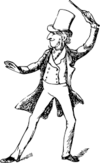Design the team you need to succeed using Belbin's team roles
(→The 9 Team Roles) |
|||
| Line 16: | Line 16: | ||
==The 9 Team Roles== | ==The 9 Team Roles== | ||
| − | + | Each team role has its strengths and allowable weakness. The strengths are a description of the positive properties that contribute to the teamwork, where the allowable weakness covers smaller less appropriate behavior which can come to show when the person works under stress. | |
| + | |||
| + | {| class="wikitable sortable" | ||
| + | |- | ||
| + | !Team Roles | ||
| + | !Characteristics | ||
| + | !Allowable weakness | ||
| + | !Function | ||
| + | |- | ||
| + | |'''Plant (PL)''' | ||
| + | [[File:lyse-ide.jpg|100px|]] | ||
| + | |Plants are innovators and inventors and can be highly creative. They provide the source of original ideas to support innovation. Usually they prefer to operates by themselves at some distance from other team members, using their imagination and often working in an unorthodox way. They tend to be introverted and react strongly to criticism and praise. their ideas may often be radical and may lack practical constraints. | ||
| + | They are independent, and usually regarded as being clever as a results of their original and radical perspective. | ||
| + | |They don't always manage to communicate in a compelling way and offer their ideas in a practical and relevant framework or they can be able to ignore incidentals because they can be too preoccupied. | ||
| + | |The main use of a Plant is to challenge conventional and established ways of doing things and provide suggested solutions for solving complex problems. Plants are often needed in the initial stages of a project or when a project is failing to progress. Plants have usually made their mark as founders of companies or as originators of new products. | ||
| + | However, too many Plants in one team or group may be counter-productive as they tend to spend their time reinforcing their own ideas and engaging each other in combat. | ||
| + | |- | ||
| + | |'''Resource Investigator (RI)''' | ||
| + | [[File:telefon.jpg|100px|]] | ||
| + | |Noget | ||
| + | |Noget 2 | ||
| + | |Noget 3 | ||
| + | |- | ||
| + | |'''Co-ordinator (CO)''' | ||
| + | [[File:dirigent.png|100px|]] | ||
| + | |Noget | ||
| + | |Noget 2 | ||
| + | |Noget 3 | ||
| + | |} | ||
==Important phases for success in the team== | ==Important phases for success in the team== | ||
Revision as of 12:25, 15 February 2021
As complex as projects can be, the people that need to solve them can be equally or even more complex and that is why there in recent years has been an increasing interest in how highly efficient teams can be designed. This task falls upon the project manager, who oversees the design and leads the team that is responsible for achieving the project objectives. [1] The beginning of a project is one of the project managers’ most important times, as the foundation of the project is laid by designing the team that he/she needs for the project to succeed. [2] A tool that can help the project manager with this task is Belbin’s team roles, which can identify personal traits and help to create balanced teams based on behavioral contributions rather than job titles. [3] The Belbin team roles were developed by Dr. Meredith Belbin with collaboration from Henley Management College in England. It contains 9 different team roles, that each has its core competencies and limitations. These can overlap but are equally important to create synergy and efficiency in a team. The model is used by over 40 percent of the top 100 companies in the UK, the United Nations, the World Bank and thousands of organizations throughout the world to enhance individual and team performance. [4]
This article will describe the when, why, and how you should design your team using the 9 Belbin team roles, the gains, limitations of the method and give a few examples of team synergies.
Contents |
Background
Text
The 9 Team Roles
Each team role has its strengths and allowable weakness. The strengths are a description of the positive properties that contribute to the teamwork, where the allowable weakness covers smaller less appropriate behavior which can come to show when the person works under stress.
| Team Roles | Characteristics | Allowable weakness | Function |
|---|---|---|---|
| Plant (PL) | Plants are innovators and inventors and can be highly creative. They provide the source of original ideas to support innovation. Usually they prefer to operates by themselves at some distance from other team members, using their imagination and often working in an unorthodox way. They tend to be introverted and react strongly to criticism and praise. their ideas may often be radical and may lack practical constraints.
They are independent, and usually regarded as being clever as a results of their original and radical perspective. |
They don't always manage to communicate in a compelling way and offer their ideas in a practical and relevant framework or they can be able to ignore incidentals because they can be too preoccupied. | The main use of a Plant is to challenge conventional and established ways of doing things and provide suggested solutions for solving complex problems. Plants are often needed in the initial stages of a project or when a project is failing to progress. Plants have usually made their mark as founders of companies or as originators of new products.
However, too many Plants in one team or group may be counter-productive as they tend to spend their time reinforcing their own ideas and engaging each other in combat. |
| Resource Investigator (RI) | Noget | Noget 2 | Noget 3 |
| Co-ordinator (CO) | Noget | Noget 2 | Noget 3 |
Important phases for success in the team
Text
Team Synergies
Text
Limitations of the Belbin analysis
Text
Applications
Text
References
- ↑ 2017 Project Management Institute, Inc. A Guide to the Project Management Body of Knowledge.
- ↑ 2016 J. R. Olsson, N. Ahrengot, M. L. Attrup. Power i Projekter og Porteføljer/
- ↑ 2018 Belbin Associates. http://www.belbin.com/
- ↑ 2015 Belbin Associates. Belbin for Students/


